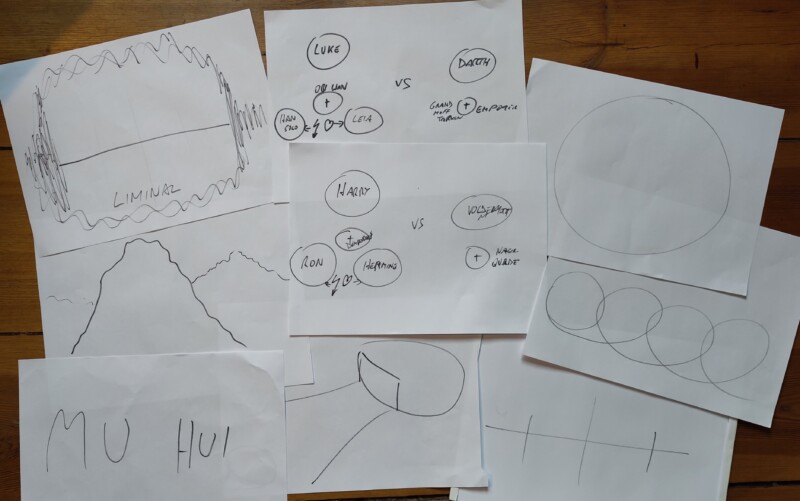These are remnants of our sessions at the wonderful Author Conference at the Leipzig Book Fair, LBM24. As you can see, we really can’t draw. Nonetheless we tried to illustrate sophisticated approaches to storytelling such as:
– figural shadowing
– liminal storytelling
– cyclical and rhythmic storytelling
We hope our participants gained some valuable insights!
Click to develop a better story:

When the bad guy makes the hero’s journey difficult.
Let’s say your hero or heroine is a falsely accused fugitive from the law. While on the run, every policeman or government agent is effectively an antagonistic obstacle. This is particularly the case if there is a specific character who represents the state and whose mission it is to catch the heroine. This detective or agent casts out the net to catch the fugitive, using all the instruments of the state at his or her disposal in order to actively thwart the heroine’s escape.
Or maybe your story is about a soldier behind enemy lines on a mission to find and destroy (or steal) the enemy’s new super weapon, or perhaps rescue an important person who has been captured. Any enemy soldiers the hero encounters are, of course, obstacles. One could say that they are external obstacles if they just happen to be there, like a patrol unit. But if there is on the enemy side a character who is aware of our hero’s approach and is actively seeking to stop him achieving his mission, then the soldiers and/or henchmen this character sends out to find the hero are not external obstacles but antagonistic obstacles.
As we have said before, this division into three classes of obstacles – internal, external, and antagonistic – is not cut and dried and need not be followed too strictly. But differentiating between the different kinds of obstacles a hero or heroine must face while designing and planning your story can lead to a more exciting plot, simply because you can disperse the obstacles systematically within the story journey and have all the different kinds of obstacle build up to a great crescendo at the climax. (more…)

Guest post by Ali Luke.
 Ali Luke is a freelance writer and novelist who blogs about making the most of your writing time at Aliventures. For her best tips on making time to write, sign up for her email newsletter: you’ll receive a free copy of her mini ebook Time to Write: How to Fit More Writing Into Your Busy Life, Right Now.
Ali Luke is a freelance writer and novelist who blogs about making the most of your writing time at Aliventures. For her best tips on making time to write, sign up for her email newsletter: you’ll receive a free copy of her mini ebook Time to Write: How to Fit More Writing Into Your Busy Life, Right Now.
Pacing in fiction is how quickly—or slowly—the story progresses. The right pace for a story depends on its genre. If you’re reading a thriller, you’ll expect a fast-paced read with lots of action; if you’re reading a historical novel or epic fantasy, you might enjoy a slower pace with lots of emphasis on the world of the story.
It’s tough to get pacing spot-on when you’re drafting. It might take you years to write a book that takes just hours for someone to read. What feels “slow” to you as you write might actually go by pretty quickly on the page. Or, you may find that you repeat yourself, going over the same narrative ground multiple times, because you barely remembered what you wrote six months ago.
So, don’t worry about your pacing as you draft. Instead, address it in the redrafts—ideally, with the help of beta readers, but even simply reading over your full manuscript yourself can help you spot areas where the pace feels off.
Here’s what to look for when redrafting your work. (more…)

How perceptive a character is of her surroundings may have dramaturgical relevance.
A character who is good at noticing small details may make a good spy or detective, so if you are developing a detective or spy you may want to give your character this ability. But whatever your character’s profession, stop at least once per scene and ask yourself,
What is a detail that only this character might notice?
Why is this important? Because their perceptions can make characters more interesting and vivid.
If a certain plot event hinges on a character perceiving some small detail or other, it may be a good idea to plant a foreshadowing moment long before the scene, to heighten the impact of the act of perception.
Furthermore, a character’s perception may influence how your audience understands and enjoys the entire story. How exactly depends on two important factors:
- narrator
- point of view
(more…)

A story has a beginning, a middle, and an end. How to avoid the ‘saggy middle’.
The middle bit of a story is really the story proper. It is usually the longest section. It comes after the introduction of the main character(s) and the setting up of the context, that is the world of the story, as well as the problems and themes the story deals with.
At the end of the first section – prior to what we’re here calling ‘the middle bit’ –, the protagonist has decided to set off on the story journey. Obviously, this does not have to be physical journey through a particular geography, but it does mean that the main character is somehow entering into new and unfamiliar terrain. In this sense, every story is a ‘fish out of water’ story. The heroine must leave the comfort zone in order for the audience to feel interest in her plight.
Some authors jump right into this unfamiliar territory, showing the run up to it in flashbacks. Anita Brookner’s heroine Edith Hope has already arrived in the Hotel du Lac in the first sentence of the novel. Gradually the reasons for her stay here are revealed as the reader progresses through the novel.
Nonetheless, for an author, it may be advisable to create a marked threshold where the protagonist enters into the alien territory of the middle bit. The exploration and transversal of this territory is what on a plot level the middle bit is about, and it takes up the greater part of the story journey. (more…)

Creation Takes Time.
This is an age of faster, faster, more, more. At the latest since the advent of the internet, everything seems to be speeding up. Processes that took weeks a few decades ago now take only a few hours, things that in the twentieth century took hours now take place within minutes or seconds. You can get from A to B in less time than ever. The requirements on most of us for most of our work call for ever greater efficiency. We must not waste time. We must be quick.
Composing a story is a painstaking process. And yes, here at Beemgee we built our fiction tool in order to make the process of composing a story more efficient. We want to make it easier to organise a plot and determine the characters’ motivations – for the authors themselves, and for all the people communicating about the story, so between interested parties such as authors and their editors or screenwriters and producers.
But though we might want our authors’ efficiency to increase, let’s not kid ourselves. Composing a story is still a painstaking process. Because most of the time is spent thinking.
Thinking takes time. And that is mostly what plotting and outlining a story really is, thinking. (more…)

The midpoint is structurally the most significant point in a narrative.
Given that stories have a tendency to symmetry, the centre of a narrative should mark the zenith of the story arc, and with that, the pivotal point of the story.
So, to get to (mid)point: What happens in the middle of a story?
Here are some typical midpoint events:
- Something searched for is found (Star Wars IV, Raiders of the Lost Ark, Lolita)
- A hidden truth is unveiled (to the audience, at least) – if not yet understood (Matrix, Pride and Prejudice, The Gruffalo)
- A dramatic event thwarts all plans made hitherto (James Cameron’s Titanic)
The centre of the narrative may be the discovery of something missing – in crime stories a vital piece of the puzzle may be revealed here (either to the audience or to the audience as well as the protagonist).
In any genre or dramatic category, the midpoint may be a moment of truth. This might be just a clue for the audience or perhaps an initial revelation of the true state of things.
If a character realises or finds out something that has so far been hidden, then this is the point at which the character begins to gain awareness. This counts in particular for the recognition of the character’s own internal problem. From here on the story might possibly lead up to a moment of choice at the crisis, when it becomes clear to the audience whether the character has learnt from this new awareness or not. In other words, the real need begins to overcome or supplant the character’s initial want due to what happens at the midpoint.
Some well-known examples of the midpoint
(more…)
Universal storytelling principles behind the most successful movie series ever.

The sumptuous music of John Barry, the stunning set designs of Ken Adam, the directorial skills of Terence Young or Guy Hamilton, the innovative editing of Peter Hunt, the screen presence of Sean Connery, the zangy theme tune by Monty Norman, memorable actresses, spectacular stunts, and exotic location scouting – a fortunate convergence of individual talents built up the abiding popularity of Ian Fleming’s literary creation, the British MI6 agent James Bond.
Most writers don’t have access to such a talent pool, nor do most authors write action-packed spy capers. Also, 007 stories in particular seem so specific a category that authors might not consider that their own works have much in common with them. So one might be tempted to think that most writers can’t learn anything useful from James Bond.
Many people say there is a James Bond formula. Guy Hamilton, director of four of the early Bond movies, has said not. But there are certainly recurring scene types and structural elements that bear examination. A closer look reveals at least seven dramaturgical principles that any author could consider applying.
- The Kick-off Event
- The Real Reason for M
- The Real Reason for Q
- A Timely Death
- The Antagonist
- Revelation and Confrontation
- Humps
(more…)

Nothing should be more important to an author than how their story makes the audience feel.
As an author, consider carefully the emotional journey of the reader or viewer as they progress through your narrative.
The audience experiences a sequence of emotions when engaged in a narrative. So narrative structure is a vital aspect of storytelling. The story should be touching the audience emotionally during every scene. Furthermore, each new scene should evoke a new feeling in order to remain fresh and surprising.
The author’s job is to make the audience feel empathy with the characters quickly, so that an emotional response to the characters’ situation is possible. Only this can lead to physical reactions like accelerated heartbeat when the story gets exciting. We have to care.
This “capturing” of the audience, making the reader or viewer rapt and enthralled, requires authors to create events that will show who the characters are and how they react to the problems they must face. The audience is more likely to feel with the characters as the plot unfolds when the characters’ reactions to events reveal something about who they really are – and how they might be similar to us.
One Journey to Spellbind Them All
Here we present a loose pattern that we think probably fits for any type of story, whatever genre or medium, however “literary” or “commercial”. It’s not prescriptive, just a rough checklist of the stages in the emotional journey the audience tacitly expects when they let themselves in on a story. The emotions are in more or less the order they might be evoked by any narrative.
Curiosity
(more…)
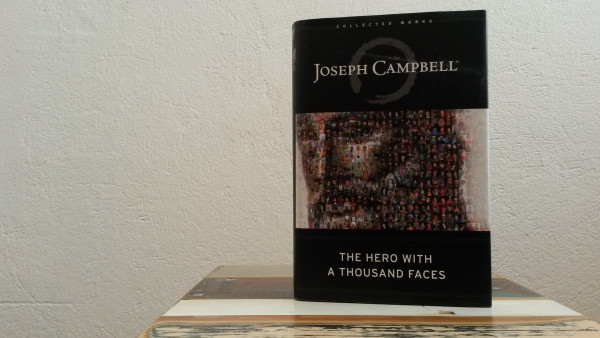
Joseph Campbell: The Hero With A Thousand Faces.
Joseph Campbell’s study of worldwide myths, The Hero With A Thousand Faces (1949), has become massively influential in commercial storytelling. Campbell was not the first to consider the concept of the hero and mythological or archetypal stories, and by no means the last (see Northrop Frye, as well as Robert Scholes and Robert Kellogg). But Campbell’s work consolidated what others, including Carl Jung, had suggested into a theory specifically about storytelling.
George Lucas read The Hero With A Thousand Faces as a young man, and we may assume that Francis Ford Coppola and Steven Spielberg were also familiar with the book. We can see the influence of Campbell’s ideas on some of the most successful movies of the 1970s and 80s, and ever since.
Christopher Vogler studied film at the same school as George Lucas, and subsequently while working at Disney wrote a seven-page breakdown of Campbell’s book. This in time developed into The Writer’s Journey, which has become the basis of the popular conception of The Hero’s Journey.
Campbell was an expert on James Joyce and a professor of literature with a particular interest in comparative mythology and comparative religion. The Hero With A Thousand Faces is by no means a how-to book or a storytelling manual. Rather, it posits the theory that all the myths of the world have elements in common and propounds the idea of the “monomyth” as a basic structural model of traditional storytelling. (more…)

Author and creative writing teacher Jesse Falzoi was born in Hamburg and raised in Lübeck, Germany. Back in the nineties, after stays in the USA and France, she moved to Berlin, where she still lives with her three children.
She has translated Donald Barthelme stories into German. Her own stories have appeared in American, Russian, Indian, German, Swiss, Irish, British and Canadian magazines and anthologies. She holds an MFA in Creative Writing from Sierra Nevada College.
Her new book on Creative Writing is released end of May 2017.
At the age of twenty-one I quit university and bought a one-way ticket to San Francisco, USA. I wanted to get far away from my first attempts to grow up. I wanted to get away from a frustrating relationship and boring courses and everything that was pushing me to take life more seriously. I didn’t have any plans what I would be doing in San Francisco but I had the address of an acquaintance I had made a year before. I went on a journey that was physical in the beginning and became more and more spiritual during the process. I bought a return ticket in the end and went back to my hometown just to pack my suitcases for good; I’d be staying in Germany, but I wouldn’t be staying home.
(more…)
A plot arises out of the actions and interactions of the characters.
On the whole, you need at least two characters to create a plot. Add even more characters to the mix, and you’ll have possibilities for more than one plot.
Most stories consist of more than one plot. Each such plot is a self-contained storyline.
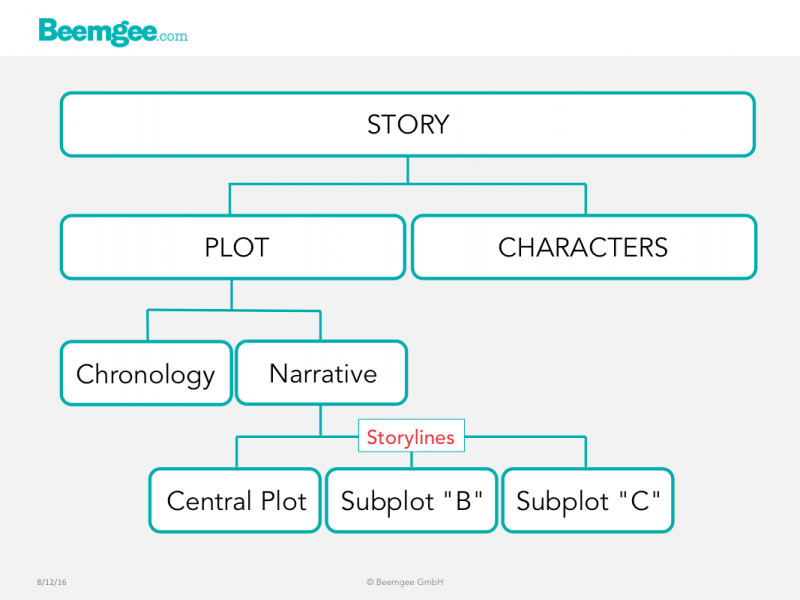
The Central Plot
Often there is a central plot and at least one subplot. The central plot is usually the one that arcs across the entire narrative, from the onset of the external problem (the “inciting incident” for one character) to its resolution. This is the plot that is at the(more…)

The protagonist is the main character or hero of the story.
Photo by Jack Moreh on Freerange
But “hero” is a word with adventurous connotations, so we’ll stick to the term protagonist to signify the main character around whom the story is built. Sometimes it is not so easy to know which is your main character.
Generally speaking, the protagonist is the character whom the reader or audience accompanies for the greater part of the narrative. So usually this character is the one with most screen or page time. Often the protagonist is the character who exhibits the most profound change or transformation by the end of the story.
Furthermore, the protagonist – and in particular what the protagonist learns – embodies the story’s theme.
For simplicity’s sake, let us say for the moment that in ensemble pieces with several main characters, each of them is the protagonist of his or her own story, or rather storyline. Since the protagonist is on the whole a pretty important figure in a story, there is a fair bit to say about this archetype, so this post is going to be quite long.
In it we’ll answer some questions:
- Is the protagonist the most interesting character in the story?
- What are the most important aspects of the protagonist for the author to convey?
- What about the transformation or learning curve?
How Interesting Must The Protagonist Be?
Some say the protagonist should be the most interesting character in the story, and the one whose fate you care about most.
But while that is often the case, it does not necessarily have to be true.
(more…)
In stories, characters are faced with obstacles.
These obstacles come in various forms and degrees of magnitude. And they may have different dimensions: they may be internal, external, or antagonistic.
Often the obstacles that resound most with a significant proportion of the audience are the ones that force the main characters to face and deal with problems within themselves, in their nature. In other words, with their internal problem.
Internal obstacles are the symptoms of the characters’ flaws or shortcomings, i.e. of the internal problem. The audience perceives them in scenes in which the character’s flaw prevents her progress.
Not every story features characters with internal problems. An internal problem is not strictly speaking necessary in order to create an exciting story.
But it helps.
The Emotional Truth
An internal problem makes the character appear fallible – and thus more credible, more human, more like us. Internal problems are invariably emotional and private. They express(more…)
The seven elements of every line of dialog in a story.
Dialog enlivens stories. But dialog in stories is very different from real spoken language. It conveys information that the audience needs to know in order to understand the story as well as the characters – the one speaking the lines as well as the one reacting to them.
There is the rule of thumb that it’s better for the author to use action to explain things or move the plot forward than dialog, at least in film. Certainly, when the author makes characters say things solely to convey some bit of knowledge to the audience or reader, the lines tend to feel false. That’s a form of exposition, explanatory stuffing. If in doubt, leave it out. You’ll be surprised how much the audience understands even without explanations.
On the other hand, Elmore Leonard noted how readers don’t usually skip dialog. People like dialog. Dialog can be exciting. Dialog can be action. So authors had better know how to write it.
Here are seven things you ought to consider about every single line of dialog you put into your characters’ mouths. We’ve created this free table to help you. Feel free to download, use and share it.
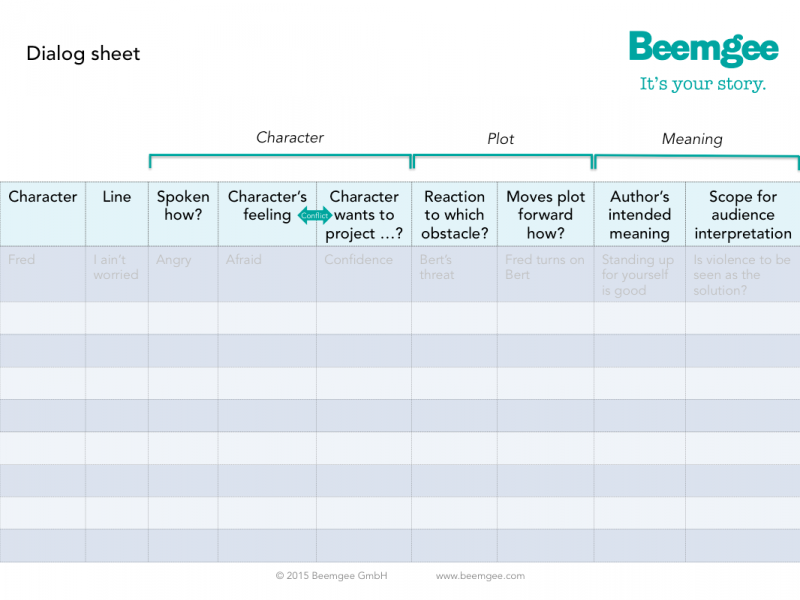
1
If you’re writing(more…)
You’re on a boat, and you see somebody fall into the water. Which of the following two cases would cause you to react with stronger emotion?
- The water is four feet deep and you know that the guy who fell in is a good swimmer
- The water is four feet deep and the person who fell in is a three year old girl who can’t swim
Presumably your emotional reaction would be stronger if the child fell off the boat. Because you know that the child’s life is at stake. The first situation is not life-threatening, the only thing at stake is the dryness of the man’s clothes and his self-esteem.
The degree you care about events that happen to people, and to yourself, is directly related to what’s at stake. This applies as much to fictional characters as in the real world.
Hence it is immensely important for storytellers to(more…)
In a story, if the treasure is what the hero wants, then slaying the dragon is the goal.
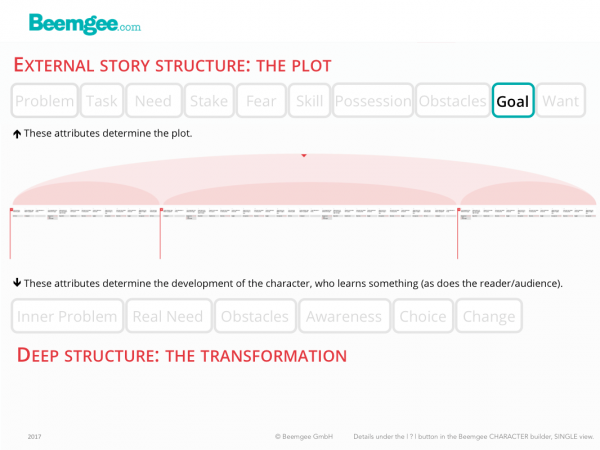
The goal is what the character thinks will lead to the (satisfaction of the) want.
Since the treasure hoard has been there for ages, there must usually be some sort of trigger for the story to get started, i.e. for the character to want the hoard now, at the time the story begins. Often, an external problem creates such a trigger. It might supply a reason why the hero needs the hoard now, something more specific than just the general sense of wanting to be rich. Perhaps the hoard isn’t the reason at all. Perhaps there is a princess in distress, which certainly adds urgency to the matter. Either way, dealing with the dragon is the goal.
If somebody says the word “goal” to you, the image that springs to mind might have to do with the ends of a football pitch. The(more…)
Action is character.
So the old storytelling adage. What does that mean, exactly?
In this post, we’ll consider:
- The central or pivotal action – the midpoint
- Actions – what the character does
- Reluctance
- Need
- Character and Archetype
The central or pivotal action – the midpoint
More or less explicitly, the main character of a story is likely to have some sort of task to complete. The task is generally the verb to the noun of the goal – rescue the princess, steal the diamond. The character thinks that by achieving the goal, he or she will get what they want, which is typically a state free of a problem the character is posed at the beginning of the story.
The action is what, specifically, the character does in order to achieve the goal (rescue the princess, steal the diamond). In many cases, this action takes place in a central scene. Central not only in importance, but central in the sense of being in the middle.
Let’s look at some examples. (more…)
In most stories, the protagonist has something to do.
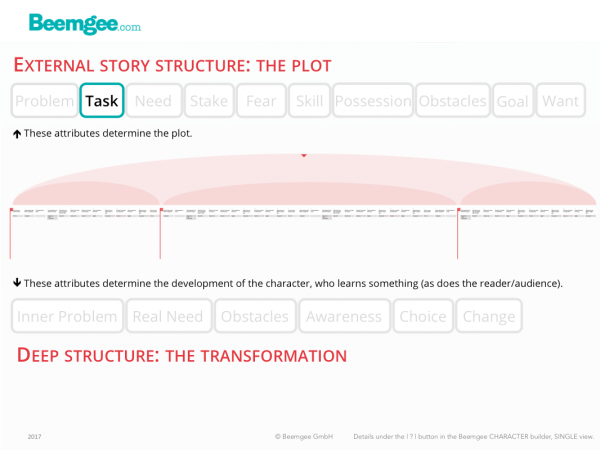
The task is the more or less explicitly defined mission a character sets out on in order to reach the goal and thereby solve the external problem.
Many of the major characters in a story will have something to do, which may result in them getting in each other’s way.
Task as Function
In a story, more or less everyone has a task. What characters do in a story defines them and determines their roles and narrative functions in the story. In this sense, it is an antagonist’s task to get in the way of the protagonist; an ally’s task is to help the protagonist; a mentor’s task is to advise the protagonist and set them on their way.
But while all that is true, it isn’t really what we mean by task.
Task as Action
The characters’ actions make them who they are. To define a character’s task is to state clearly what that character has to achieve in the story. It is the action that leads to(more…)
If there is one thing that ALL stories have in common, it is change.
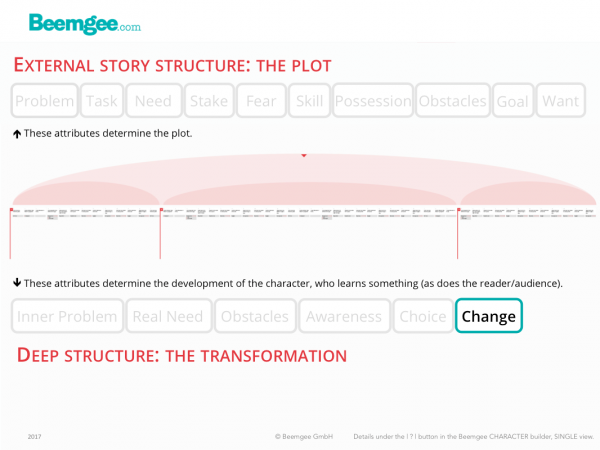
A story, pretty much by definition, describes a change. Indeed, every single scene does.
Within a story, what changes?
At the very least,
- one of the characters, usually the protagonist
- often other characters too
- sometimes the whole story-world
- who understands what – the perception of what is true or valuable
1 – The protagonist changes
We have said before that a protagonist is usually wiser at the end of the story than at the beginning. We have seen that this has something to do with the want, which – whether the character achieves it or not – is usually only attainable by causing a change. Often the change involves the character’s solving the internal problem, so the change takes place within the character. This involves the recognition of the necessity for change, i.e. the acceptance of the real need, and the struggle to achieve it. So all the incidents and events in the plot, the hindrances and obstacles the characters deal with, are in themselves not so very interesting. What interests the audience more is how these events and obstacles change the character.
Having said that, a story may well show no more change than the solving of an external problem. A story world is disturbed, but at the end returns to a similar state. For instance in a detective story, where the crime is solved but the protagonist does not really develop.
2 – Several characters change
Characters don’t change in a vacuum. They learn through interactions with each other. Relationships cause change. In many stories, subplots will tell of the characters that surround the protagonist, and their changes and developments may well cast light on various aspects of the story’s theme. Or perhaps the story is an ensemble piece, where it is not easy (or even necessary) to identify a main protagonist. Or it is a romance, or buddy-story, which apparently has two main characters. Whichever – some level of change usually occurs in all the main characters as a result of how they interact with each other.
There is, by the way, one often neglected archetype who also typically changes. This role is sometimes referred to as foil. We call it the role of the contrastor. The contrastor mirrors and contrasts the protagonist, like Han Solo to Luke Skywalker in Star Wars or the mother to the boy in Boyhood.
3 – The whole world changes
Quite possibly, the entire story-world may be different by the end of the story than it was at the beginning. Story-world as a concept refers to the scope of the world presented in the story, so if the field of action of the characters is small, the story-world is small too. If the story is an epic, the story-world will be big, a version of an entire world.
As an aside on this last point, consider the classical genres. Epics – again, almost by definition – describe a change in a whole world. In a way, so does tragedy, for at the end of the tragedy the world will have lost one or more of its population, since tragedy deals with the change from life to death.
Comedy seeks to describe a different fundamental change in the story-world. The typical structure of comedy, whether we are talking about Aristophanes or modern TV sitcoms, has a stable situation at the beginning which is disturbed by some event or problem. The disturbance causes first a lot of messy but generally non-life-threatening chaos which is resolved by a return to the original undisturbed situation. Even if the main characters end up married, for example, the story-world is brought back to its stable state.
The very serious point of comedy is to demonstrate a fundamental truth: the cyclical nature of change in the universe. Spring always returns, no matter how bleak the winter. Day always comes, no matter how dark the night. Change does not have to be final. Change can be cyclical. Change is life.
4 – The Perception of Truth
The most fundamental change that stories tend to describe is one of recognition of truth. What is not known at the beginning of the story is recognised and thus becomes known at the end. This is obvious in crime stories, but holds true for almost all other stories too. The story therefore amounts to an act of learning. Often the learning curve is observable in the protagonist, who tends to be wiser at the end than at the beginning.
But the point is really that the recipient, the reader or viewer, is actually the one doing the learning – through experiencing the story.
The audience changes.
At least, that’s the general idea. The story provides a physical, emotional and intellectual experience – physical when your heart beats faster or your palms sweat, emotional when you feel for the characters, and perhaps intellectual too if the story gives you pause for thought. If the story achieves none of these responses, then it has failed. An experience, again pretty much by definition, changes you. We learn through experience; so if you have changed, chances are it’s because you have learnt something.
Hence it is not only within the story that a change takes place. It takes place outside of the story as well, in the recipient.
Within some stories one may argue that no real change occurs – Alice does not obviously change due to her experience in Wonderland. But the reader has been taken on a wild journey, and the experience is likely to have left some sort of mark.
How does a story provide an experience?
By allowing the recipient, the audience or reader, to understand and feel change and transformation throughout the story. Every scene describes a change. The entire narrative shows a difference between the “before and after”. Stories have a tendency to symmetry: The beginning of the story makes clear what the state of the protagonist or the story world is before the story journey commences, and the end of the story has a corresponding scene or event that shows what the state is after.
For the author, then, the task is to clearly know the state of things for the protagonist, the cast of characters, the story world, and the audience at the end of the tale, and the state of things at the beginning of the tale. The greater the contrast, the better. Once these two points of reference are known, the author works out the many steps needed to get the protagonist, the cast of characters, the story world, and the audience from one state to the other.
There is a paradox here. The change that occurs is also an expression of new equilibrium. At a very basic level, story structure can be described as follows:
- an external problem (a change in the ordinary world of the protagonist) disturbs the equilibrium of the initial situation
- the disturbance is explored, a struggle ensues in which obstacles must be overcome
- the problem is understood and dealt with, creating a new equilibrium or resolution
So change is all-pervasive in stories, within them in the form of character development, and without in the form of audience understanding. And that is not even to consider the transformational power of telling a story, when the act of telling the story brings about change in the author.
Read here how change is important for every single scene, though we prefer to call them plot events.
Related function in the Beemgee story development tool:
Character Developer
Not developing your story yet? Click here:
A character with a goal needs to do something in order to reach it.
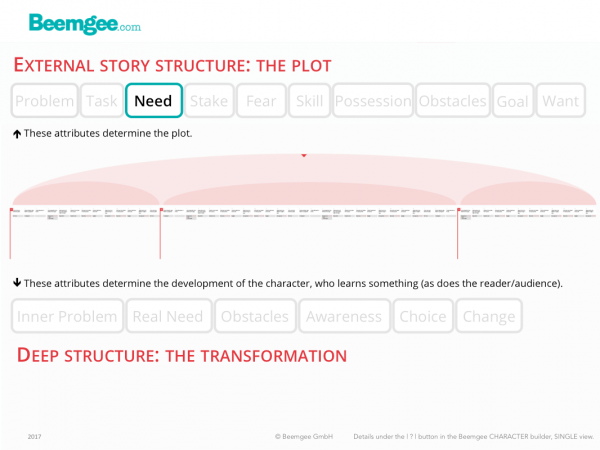
The outward needs of a character – things she needs to acquire or achieve in order to reach the goal – divide the story journey into stages.
In storytelling, characters usually know they have a problem and there is usually something they want. They tend to set themselves a goal which they believe will solve their problem and get them what they want.
In order to get to the goal, the character will need something. Some examples: If the goal is a place, a means of transportation is necessary to get there. If we can’t rob the bank alone, we’ll have to persuade some allies to join our heist. If the goal is defeating a dragon, then some weapons would be helpful. If magic is needed, we’ll have to visit the magician to pick some up.
While the perceived need might be an object or a person, it usually requires an action. We’ll need a car, so do we buy one or steal one? We’ll need a sword, so do we pull one out of a stone or go to the blacksmith? If we need help, who do we ask and how do we talk them into joining us? We’ll need magic, but how do we find a magician? Ask an elf or go to the oracle for advice?
So, once the goal is set, a vision of the way to reach it opens up to the protagonist – and with that to the audience/reader. At the very least, the first step of the way presents itself. All this is what the character is conscious of.
In other words, the character forms a plan.
The plan is communicated more or less explicitly to the audience. The anticipation of how things will not go quite according to plan is part of the pleasure. There must always be surprises in store for the characters as well as for the audience.
Stages and Obstacles
The perceived needs are (more…)
What’s the problem? Does the character know?
In storytelling, discrepancy between a character’s awareness and the awareness-levels of others is one of the most powerful devices an author can use. “Others” refers here not just to other characters, but to the narrator and – most significantly – to the audience/reader.
Let’s sum up potential differences in knowledge or awareness:
- A character’s awareness of his or her own internal problem or motivation
- A difference between one character’s knowledge of what’s going on and another’s
- The narrator knows more about what is going on than the character
- The audience/reader knows more than the character – dramatic irony
In this post, we’ll concentrate on the first point: Awareness of the internal problem. We’ll break that down into
- Becoming Aware – the importance of the revelation
- The Story Journey – and where to place the revelation
- Surface Structure and Deep Structure
- The Need for Awareness – or, Alternatives to Revelation
Becoming Aware – the importance of the revelation (more…)
